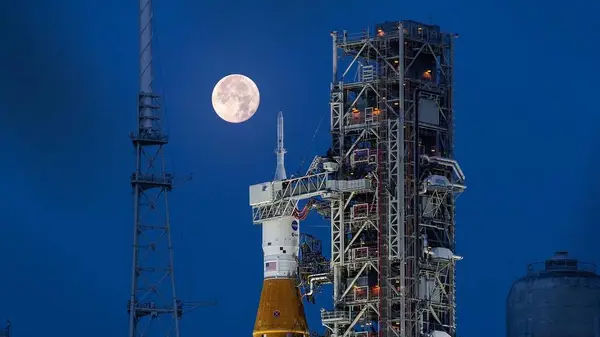The Artemis I is NASA’s first mission to the moon in nearly a generation. The launch is set to take place on August 29.
This is the latest programme from NASA and is an effort to help establish the first long-term presence on the Moon. However, the Artemis I launch that will be launching in just over 12 hours is part of a larger attempt by the space agency to put humans on Mars.
Here is all you need to know about the upcoming space launch:
When does it launch?
NASA’s Space Launch system received the “go for launch” command on August 22 following a flight readiness review. The launch will take place from the Kennedy Space Center on Merrit Island, Florida. It will happen over a two-hour window that starts at 8:33 am Eastern Time, 6:03 pm Indian Standard Time. Should the launch be aborted, there are secondary launch windows being prepped for September 2 and September 5.
Also Read: What are the important aspects of NASA’s Artemis programme?
What is inside the Orion Spacecraft?
As mentioned earlier, this is a test flight, but that doesn’t mean that the Orion module is going to be going without any crew. Three mannequins named Campos, Helga and Zohar have been placed within Orion and are expected to demonstrate what would potentially happen to astronauts on this space journey.
What is NASA’s objective with the Artemis I launch?
On August 3, the mission manager of Artemis I, Mike Sarafin said in a press conference that the current mission had four objectives.
Firstly, the test launch will determine if the Orion Spacecraft, the human habitation module, will be able to safely re-enter Earth’s atmosphere. It will test whether the heat shield on Orion is adequate.
Secondly, NASA will use this test flight to demonstrate its own capacity and capabilities for missions like this. According to the space agency’s press kit, the launch will showcase “NASA’s launch facilities and ground-based infrastructure, SLS operations, including separation events during ascent, Orion operations in space, and recovery procedures.”
Third, how it retrieves Orion after it splashes down back on Earth. The ground teams will analyse how the spacecraft fared and whether there were “engineering uncertainties”. Everything to do with Orion will be analysed, from the data gathered by the three mannequins to the parachute system deployed during atmospheric re-entry.
Finally, NASA has a host of side missions planned, like the deployment of 10 cubesats, image gathering and certifying Orion’s optical navigation system. Cubesats are miniature satellites that are 10 cm and have a mass of no more than 2 kilograms.
How much did it cost?
The Artemis programme has been plagued by delays and technical issues, driving costs up. So far, Artemis I costs $4 billion, with Orion costing $20.3 billion alone. Over all however, the entire project is expected to cost American taxpayers nearly $93 billion by 2025. The Space Launch System which is expected to be the first of its kind launch rocket for deep space exploration has cost $23 billion so far.
Why is Artemis I a test flight?
NASA has decided to limit the SLS test flight to just one as that is what their budget allows. The next SLS will include human astronauts and is expected to launch in 2024. This is the space agency’s only chance to gather as much data as it possibly can before sending Astronauts in the Orion on the Artemis II.







